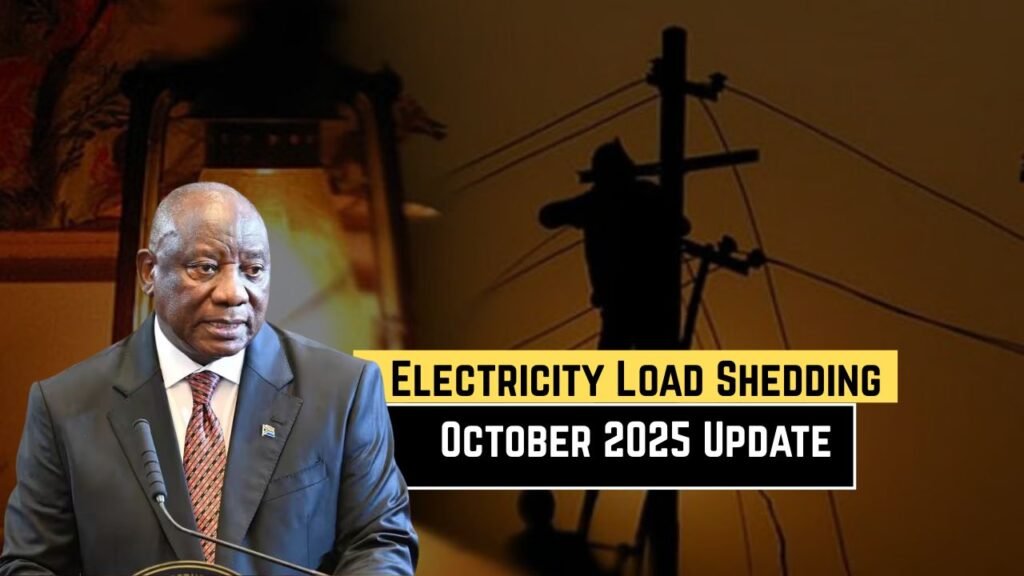Electricity Load Shedding – Electricity load shedding has become a recurring challenge for South Africa, and the release of the updated area-wise schedule for October 2025 brings both clarity and concern for households and businesses. With rising energy demands and ongoing maintenance at key power stations, the October schedule highlights periods of planned outages designed to balance the national grid and prevent total blackouts. For many citizens, these planned interruptions disrupt daily routines, from cooking and studying to running small businesses, making it essential to know when power cuts will happen. Businesses, in particular, face added costs as they rely on generators or alternative energy solutions to keep operations running. The release of the official schedule aims to provide communities with advance notice, enabling them to prepare better and adapt to the challenges of reduced electricity supply. This update also sheds light on Eskom’s broader strategy to stabilize the grid while pursuing long-term energy reforms.

Impact of Load Shedding on Households and Businesses
The updated October 2025 schedule emphasizes the strain placed on both households and businesses during frequent outages. Families often experience disruptions to essential activities such as cooking meals, children completing homework, and accessing online learning platforms. For businesses, particularly small and medium-sized enterprises, the impact is even more severe as revenue losses accumulate during power cuts. Many have had to invest in backup systems like solar panels and generators, which adds financial pressure. In rural areas, where backup solutions are scarce, the effects are harsher as communities remain cut off from basic services. The consistency of load shedding has also driven more people to explore renewable energy, but adoption remains limited due to high costs. Knowing the schedule in advance offers some relief, as families and companies can plan tasks around outages, though it does not resolve the deeper issue of unreliable electricity supply.
Eskom’s Strategy and Government Responses
The October 2025 load shedding schedule is part of Eskom’s broader effort to stabilize the national grid amid ongoing generation challenges. Power station breakdowns, insufficient maintenance, and rising demand have created a cycle of shortages that Eskom continues to struggle with. The government has acknowledged the economic risks of ongoing outages, particularly on job creation, foreign investment, and economic growth. As a result, officials have announced fast-tracking of renewable projects, including solar and wind farms, to diversify the energy mix. Additionally, private sector participation is being encouraged through policy reforms that allow businesses to generate and sell power back to the grid. While these strategies provide hope for a more stable energy future, immediate relief remains dependent on managing available capacity. The release of detailed schedules reflects transparency efforts, yet many South Africans remain frustrated with the long wait for lasting solutions.
Community Adaptation and Coping Mechanisms
Despite the challenges, communities across South Africa have shown resilience in adapting to frequent power cuts. Many households now rely on gas stoves, rechargeable lights, and solar-powered devices to maintain some normalcy during blackouts. In urban centers, restaurants and retail outlets have adopted creative solutions like time-based discounts or delivery services adjusted around outage periods. Schools are adjusting timetables to maximize teaching hours during periods of power availability, while some have invested in small-scale solar systems to keep digital learning tools running. Community WhatsApp groups and social media platforms are also playing a vital role in keeping people updated about local power conditions, often faster than official updates. These adaptations highlight the determination of South Africans to maintain productivity and quality of life, even as uncertainty continues. However, reliance on temporary fixes underlines the urgency for sustainable long-term solutions.
Future Outlook for South Africa’s Power Supply
Looking ahead, the future of South Africa’s power supply remains uncertain, but not without hope. The government’s push for renewable energy, combined with independent power producers entering the market, could significantly reduce reliance on coal-fired plants over the next decade. Large-scale investments in infrastructure, such as transmission upgrades and battery storage, are also being considered to stabilize supply. If executed effectively, these reforms could mark the beginning of the end for constant load shedding. However, delays in policy implementation, corruption scandals, and funding gaps remain major barriers. Citizens continue to call for urgent accountability and transparency, pressing leaders to prioritize the electricity crisis above all else. The October 2025 schedule may provide short-term clarity, but long-term stability depends on bold action. Without consistent reforms and investment, the cycle of blackouts could persist, threatening South Africa’s economic resilience and quality of life.






